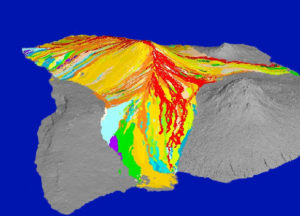The Largest Volcano on Earth
Mauna Loa, or “Long Mountain” as its name means in Hawaiian, is considered the largest active shield volcano on Earth by mass and volume. Together with four other volcanoes, (including the famous Mauna Kea) it makes up the island of Hawaii. Standing at an elevation of 4167m (13,679ft) and a total height from base to peak at 9168.4m (30,080ft). Although it may not be the tallest volcano, as compared to Mauna Kea, Mauna Loa is so huge that it depresses the ocean floor, rises almost 9 km (5.6 miles) from the ocean floor, and stretches 119km (74 miles) from end to end. By itself, it makes up over half of the Big Island! (HCV; USGS)
Located at the summit of Mauna Loa is a 3-km by 5-km caldera, Mokuaweoweo, and rift zones extending east-northeast and southwest from the caldera. (Lockwood and Lipman,1987)
Mauna Loa has an extensive eruptive history. Since 1832, it has erupted 33 times, with the most recent one being in 1984. These eruptions have occurred either as summit eruptions, in the immediate area of Mokuaweoweo, or flank eruptions, where most volcanic volume is produced at lower altitudes. Geologists are confident that it will erupt again in the future as well, and monitor all seismic activity extensively.
Eruptions from Mauna Loa tend to be non-explosive, olivine dominated lava flows. (Wright, 1972)
Want to visit Mauna Loa? There are a couple of things you can do there:
- Hiking
- Keep in mind that a hike to Mauna Loa’s summit is about 13 miles round trip! Be prepared. We recommend reading about hiking Mauna Loa at bigislandhikes.com before you go.
- Camping
- Get your permit to camp overnight before you start out.
It’s a good idea to check the weather conditions before you hike! See an updated weather forecast for Mauna Loa here. Don’t assume that the weather on Mauna Loa will be balmy and pleasant: it’s still a large mountain and gets near freezing during summer and well below zero with snow in winter especially at night. Many hikers are unprepared for extreme blizzards and winter storms. An excellent resource is the webcams.
We highly recommend that you visit the USGS website to learn about current volcano hazards and alerts before you visit. Always stay informed!

